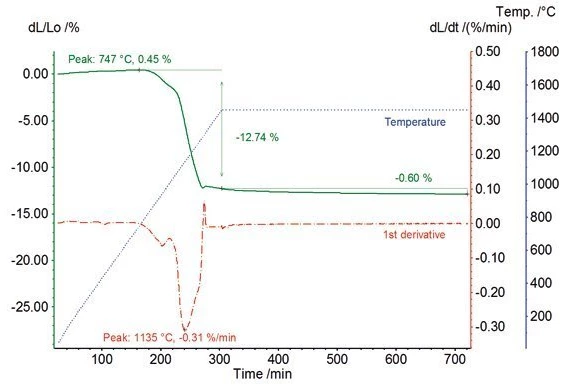CERAMICS & GLASS
Aluminum Titanate — Sintering
One use of aluminum titanate is as a carrier material for catalytic converters in the automobile industry.
Shown here is the measurement of an aluminum titanate green body in the temperature range from RT to 1450°C with a subsequent IsothermalTests at controlled and constant temperature are called isothermal.isothermal line at 1450°C of 7 hours. During the heating, shrinkage of 12.7% is observed. The SinteringSintering is a production process for forming a mechanically strong body out of a ceramic or metallic powder. sintering takes place in 2 steps with a maximum SinteringSintering is a production process for forming a mechanically strong body out of a ceramic or metallic powder. sintering rate of 0.31%/min. In the subsequent IsothermalTests at controlled and constant temperature are called isothermal.isothermal phase, further shrinkage of 0.6% occurs. To optimize the SinteringSintering is a production process for forming a mechanically strong body out of a ceramic or metallic powder. sintering process, an Rate-Controlled Sintering (RCS)The properties of sintered products, such as density or particle size distribution, are determined by the sintering conditions (temperature, atmosphere, etc.) and especially by the sintering rates. RCS measurement (Rate-Controlled Sintering (RCS)The properties of sintered products, such as density or particle size distribution, are determined by the sintering conditions (temperature, atmosphere, etc.) and especially by the sintering rates. rate controlled sintering; optionally available) can additionally be carried out. (measurement with TMA 402 F1 /F3 Hyperion®®)
